The global nanocatalysts market is likely to reach from USD 2.8 billion in 2025 to approximately USD 7.2 billion by 2035, recording an absolute increase of USD 4.35 billion over the forecast period. This translates into a total growth of 152.6%, with the market forecast to expand at a compound annual growth rate (CAGR) of 9.7% between 2025 and 2035. The market size is expected to grow by nearly 2.5X during the same period, supported by increasing demand for efficient catalytic processes, rising adoption of green chemistry practices, and growing focus on sustainable industrial processes and environmental remediation applications.
Quick Stats for Nanocatalysts Market
Between 2025 and 2030, the nanocatalysts market is projected to expand from USD 2.8 billion to USD 4.6 billion, resulting in a value increase of USD 1.7 billion, which represents 40.2% of the total forecast growth for the decade. This phase of growth will be shaped by rising demand for advanced catalytic solutions in petrochemical industries, increasing adoption of nanocatalysts in environmental applications, and growing penetration of energy-efficient catalytic processes in emerging markets. Chemical and materials companies are expanding their nanocatalyst product portfolios to address the growing demand for high-performance catalytic solutions.
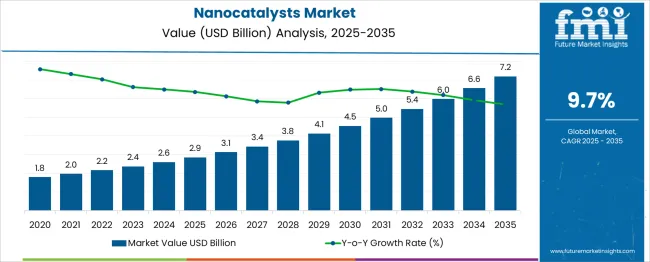
| Metric | Value |
| Estimated Value in (2025E) | USD 2.8 billion |
| Forecast Value in (2035F) | USD 7.2 billion |
| Forecast CAGR (2025 to 2035) | 9.7% |
From 2030 to 2035, the market is forecast to grow from USD 4.6 billion to USD 7.2 billion, adding another USD 2.6 billion, which constitutes 59.8% of the ten-year expansion. This period is expected to be characterized by expansion of sustainable catalytic processes, integration of advanced nanotechnology in industrial applications, and development of specialized nanocatalyst solutions for emerging industries. The growing adoption of green manufacturing practices and environmentally friendly catalytic processes will drive demand for high-performance nanocatalysts with enhanced efficiency and selectivity profiles.
Between 2020 and 2025, the nanocatalysts market experienced robust expansion, driven by increasing industrial focus on process optimization and growing awareness of the environmental benefits of advanced catalytic systems. The market developed as chemical manufacturers recognized the need for efficient catalytic solutions to improve reaction rates, reduce energy consumption, and minimize environmental impact. Research and development investments began emphasizing the importance of nanocatalysts in achieving sustainable industrial processes and meeting regulatory requirements.
Market expansion is being supported by the increasing industrial demand for efficient catalytic processes and the corresponding need for advanced materials that can enhance reaction rates while reducing energy consumption. Modern industries are increasingly focused on sustainable manufacturing practices that can minimize environmental impact, reduce waste generation, and improve the efficiency. Nanocatalysts' proven effectiveness in accelerating chemical reactions while maintaining high selectivity makes them a preferred choice in industrial applications across multiple sectors.
The growing emphasis on environmental sustainability and green chemistry is driving demand for nanocatalysts that can enable cleaner production processes and reduce harmful emissions. Industrial preference for multifunctional catalysts that combine high activity with stability and reusability is creating opportunities for innovative nanocatalyst formulations. The rising influence of regulatory requirements for environmental protection and the need for cost-effective manufacturing processes is also contributing to increased adoption across different industrial sectors and applications.
The market is segmented by material outlook, application outlook, and region. By material outlook, the market is divided into metal-based nanocatalysts, metal oxide nanocatalysts, carbon-based nanocatalysts, polymeric nanocatalysts, and composite nanocatalysts. Based on application outlook, the market is categorized into petroleum refining, chemicals, environmental, energy & fuel cells, automotive, electronics & semiconductor, food & beverage, and pharmaceuticals & biotechnology. Regionally, the market is divided into North America, Europe, Asia Pacific, Latin America, and Middle East & Africa.
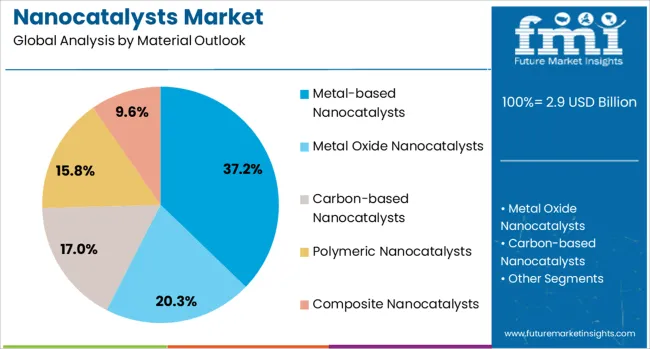
The metal-based nanocatalysts segment is projected to account for 37.2% of the nanocatalysts market in 2025, reaffirming its position as the category's leading material type. Industrial users increasingly recognize the superior catalytic activity and versatility of metal-based nanocatalysts in various chemical reactions and processes. These catalysts offer exceptional performance in terms of reaction rate enhancement, selectivity, and stability under diverse operating conditions.
This segment forms the foundation of most industrial catalytic applications, as it represents the most proven and widely adopted nanocatalyst technology. Research validation and ongoing industrial applications continue to strengthen confidence in metal-based nanocatalyst formulations. With industrial processes requiring increasingly efficient and reliable catalytic solutions, metal-based nanocatalysts align with both performance optimization and cost-effectiveness goals. Their broad applicability across multiple industries ensures sustained market dominance, making them the central growth driver of nanocatalyst demand.
Petroleum refining is projected to represent 31.7% of nanocatalyst demand in 2025, underscoring its role as the primary application sector for advanced catalytic technologies. The petroleum industry gravitates toward nanocatalysts for their ability to enhance refining efficiency, improve product quality, and reduce processing costs. Positioned as critical components in refining processes, nanocatalysts offer both performance benefits, such as increased conversion rates, and operational advantages, including reduced energy consumption and longer catalyst life.
The segment is supported by the continuous need for refining optimization and the industry's focus on meeting stringent environmental regulations. The refineries are increasingly adopting advanced catalytic technologies that combine nanocatalysts with process optimization systems, enhancing total operational efficiency and justifying capital investments. As the petroleum industry prioritizes efficiency and environmental compliance, nanocatalyst-based refining processes will continue to dominate application demand, reinforcing their critical positioning within the industrial catalysis market.
The nanocatalysts market is advancing rapidly due to increasing industrial demand for process optimization and growing emphasis on sustainable manufacturing practices. The market faces challenges including high development costs, technical complexities in large-scale production, and regulatory uncertainties regarding nanomaterial safety. Innovation in catalyst design and sustainable manufacturing processes continue to influence product development and market expansion patterns.
The growing adoption of environmentally friendly manufacturing processes is enabling industries to implement cleaner production methods and reduce environmental impact. Green chemistry principles offer sustainability benefits, improved regulatory compliance, and reduced waste generation that influence operational decisions. Environmental regulations and corporate sustainability commitments are driving adoption of nanocatalyst technologies, particularly among industries seeking to minimize their environmental footprint.
Modern nanocatalyst manufacturers are incorporating advanced synthesis techniques such as controlled precipitation, sol-gel methods, and template-assisted synthesis to enhance catalyst performance and consistency. These technologies improve the activity and selectivity of nanocatalysts while extending operational lifetime and providing better process control. Advanced design approaches also enable customized catalysts that deliver specific performance characteristics for targeted industrial applications.
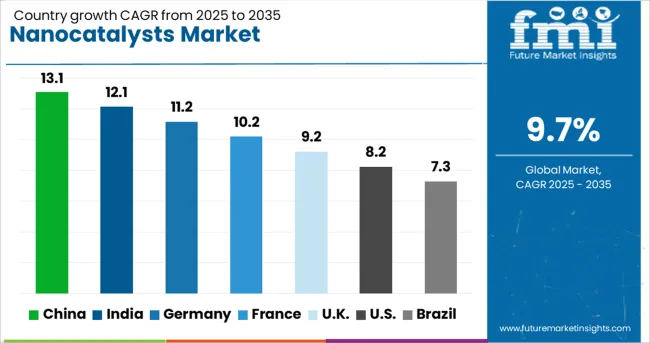
| Country | CAGR (2025-2035) |
| China | 13.1% |
| India | 12.1% |
| Germany | 11.2% |
| France | 10.2% |
| UK | 9.2% |
| USA | 8.2% |
| Brazil | 7.3% |
The nanocatalysts market is experiencing robust growth globally, with China leading at a 13.1% CAGR through 2035, driven by rapid industrial expansion, increasing chemical production capacity, and growing adoption of advanced catalytic technologies. India follows closely at 12.1%, supported by expanding manufacturing sector, rising industrial investments, and increasing demand for efficient catalytic processes. Germany shows steady growth at 11.2%, emphasizing advanced catalyst technologies and sustainable manufacturing practices. France records 10.2%, focusing on petrochemical applications and specialty catalyst development. The UK shows 9.2% growth, prioritizing sustainable chemistry and advanced materials research.
The report covers an in-depth analysis of 40+ countries; six top-performing countries are highlighted below.
Revenue from nanocatalysts in China is projected to exhibit strong growth with a CAGR of 13.1% through 2035, driven by rapid expansion of chemical and petrochemical industries and increasing adoption of advanced manufacturing technologies. The country's massive industrial base and growing emphasis on process optimization are creating significant demand for high-performance nanocatalyst solutions. Major international and domestic chemical companies are establishing comprehensive production facilities to serve the growing population of industrial users across tier-1 and tier-2 cities.
Revenue from nanocatalysts in India is expanding at a CAGR of 12.1%, supported by increasing industrial investments, growing chemical sector, and rising adoption of advanced catalytic technologies. The country's expanding manufacturing base and increasing focus on process efficiency are driving demand for effective nanocatalyst solutions. International technology companies and domestic manufacturers are establishing production and distribution channels to serve the growing demand for industrial catalytic products.
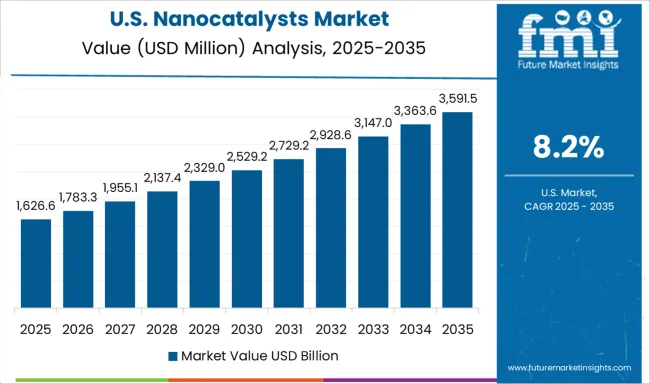
Demand for nanocatalysts in the USA is projected to grow at a CAGR of 8.2%, supported by industrial preference for advanced catalytic technologies and regulatory requirements for environmental compliance. American industries are increasingly focused on process optimization, operational efficiency, and sustainable manufacturing practices. The market is characterized by strong demand for high-performance formulations that combine nanocatalyst effectiveness with environmental responsibility.
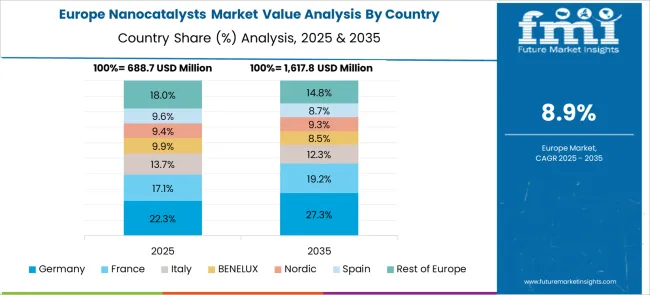
Revenue from nanocatalysts in Germany is projected to grow at a CAGR of 11.2% through 2035, driven by the country's strong chemical industry, advanced manufacturing capabilities, and commitment to technological innovation. German industries consistently demand high-quality, technologically advanced products that deliver superior performance while maintaining operational safety and environmental compliance.
Revenue from nanocatalysts in France is projected to grow at a CAGR of 10.2% through 2035, supported by the country's established petrochemical sector and growing industrial demand for advanced catalytic solutions. French industries value technological innovation, operational efficiency, and proven performance, positioning nanocatalysts as a core component of industrial process optimization strategies.
Revenue from nanocatalysts in the UK is projected to grow at a CAGR of 9.2% through 2035, supported by the country's emphasis on sustainable manufacturing, advanced materials research, and industrial innovation. British industries prioritize technological advancement, environmental responsibility, and operational efficiency, making nanocatalysts a trusted choice in the advanced manufacturing segment.
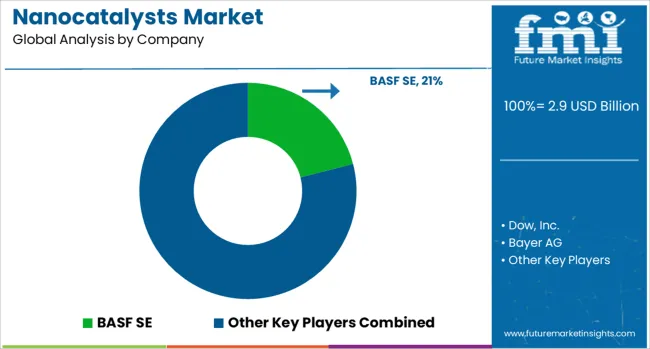
The nanocatalysts market is characterized by competition among established chemical companies, specialty materials manufacturers, and emerging nanotechnology players. Companies are investing in advanced synthesis technologies, sustainable production practices, product innovation, and strategic partnerships to deliver effective, reliable, and accessible nanocatalyst solutions. Technology development, industrial applications, and market expansion are central to strengthening product portfolios and market presence.
BASF SE, Germany-based, leads the market with 21.0 percent global value share, offering comprehensive nanocatalyst solutions with focus on industrial applications and advanced manufacturing. Dow Inc., United States, provides high-performance nanocatalyst technologies with emphasis on process optimization and industrial integration. Bayer AG, Germany, delivers specialized nanocatalyst formulations targeting chemical process applications and operational efficiency. Evonik Industries AG, Germany, develops innovative nanocatalyst solutions that integrate advanced materials science with industrial performance requirements.
NanoScale Corporation and Nanophase Technologies Corporation, both United States-based, supply specialized nanocatalyst products designed for diverse industrial applications and technology platforms. Catalytic Solution Inc., United States, focuses on customized catalytic solutions tailored to specific industrial requirements. Hyperion Catalysis International offers advanced carbon-based nanocatalyst technologies applied in industrial and automotive sectors. Headwaters NanoKinetix Inc. and Nanostellar Inc., United States, provide innovative nanocatalyst solutions with emphasis on emerging industrial applications and technology development.
| Items | Values |
|---|---|
| Quantitative Units (2025) | USD 2.85 Billion |
| Material Outlook | Metal-based Nanocatalysts, Metal Oxide Nanocatalysts, Carbon-based Nanocatalysts, Polymeric Nanocatalysts, Composite Nanocatalysts |
| Application Outlook | Petroleum Refining, Chemicals, Environmental, Energy & Fuel Cells, Automotive, Electronics & Semiconductor, Food & Beverage, Pharmaceuticals & Biotechnology |
| Regions Covered | North America, Europe, Asia Pacific, Latin America, Middle East & Africa |
| Countries Covered | United States, Canada, United Kingdom, Germany, France, China, Japan, South Korea, India, Brazil, Australia and 40+ countries |
| Key Companies Profiled | BASF SE, Dow Inc, Bayer AG, Evonik Industries AG, NanoScale Corporation, Nanophase Technologies Corporation, Catalytic Solution Inc, Hyperion Catalysis International, Headwaters NanoKinetix Inc, Nanostellar Inc |
| Additional Attributes | Industrial applications by catalyst type and performance characteristics, regional demand trends, competitive landscape, industrial preferences for metal versus non-metal based catalysts, integration with sustainable manufacturing practices, innovations in catalyst synthesis and production scaling, controlled activity optimization, and environmental compliance requirements |
Metal-based Nanocatalysts
Petroleum Refining
The global nanocatalysts market is estimated to be valued at USD 2.9 billion in 2025.
The market size for the nanocatalysts market is projected to reach USD 7.2 billion by 2035.
The nanocatalysts market is expected to grow at a 9.7% CAGR between 2025 and 2035.
The key product types in nanocatalysts market are metal-based nanocatalysts, metal oxide nanocatalysts, carbon-based nanocatalysts, polymeric nanocatalysts and composite nanocatalysts.
In terms of application outlook , petroleum refining segment to command 31.7% share in the nanocatalysts market in 2025.






Our Research Products

The "Full Research Suite" delivers actionable market intel, deep dives on markets or technologies, so clients act faster, cut risk, and unlock growth.

The Leaderboard benchmarks and ranks top vendors, classifying them as Established Leaders, Leading Challengers, or Disruptors & Challengers.

Locates where complements amplify value and substitutes erode it, forecasting net impact by horizon

We deliver granular, decision-grade intel: market sizing, 5-year forecasts, pricing, adoption, usage, revenue, and operational KPIs—plus competitor tracking, regulation, and value chains—across 60 countries broadly.

Spot the shifts before they hit your P&L. We track inflection points, adoption curves, pricing moves, and ecosystem plays to show where demand is heading, why it is changing, and what to do next across high-growth markets and disruptive tech

Real-time reads of user behavior. We track shifting priorities, perceptions of today’s and next-gen services, and provider experience, then pace how fast tech moves from trial to adoption, blending buyer, consumer, and channel inputs with social signals (#WhySwitch, #UX).

Partner with our analyst team to build a custom report designed around your business priorities. From analysing market trends to assessing competitors or crafting bespoke datasets, we tailor insights to your needs.
Supplier Intelligence
Discovery & Profiling
Capacity & Footprint
Performance & Risk
Compliance & Governance
Commercial Readiness
Who Supplies Whom
Scorecards & Shortlists
Playbooks & Docs
Category Intelligence
Definition & Scope
Demand & Use Cases
Cost Drivers
Market Structure
Supply Chain Map
Trade & Policy
Operating Norms
Deliverables
Buyer Intelligence
Account Basics
Spend & Scope
Procurement Model
Vendor Requirements
Terms & Policies
Entry Strategy
Pain Points & Triggers
Outputs
Pricing Analysis
Benchmarks
Trends
Should-Cost
Indexation
Landed Cost
Commercial Terms
Deliverables
Brand Analysis
Positioning & Value Prop
Share & Presence
Customer Evidence
Go-to-Market
Digital & Reputation
Compliance & Trust
KPIs & Gaps
Outputs
Full Research Suite comprises of:
Market outlook & trends analysis
Interviews & case studies
Strategic recommendations
Vendor profiles & capabilities analysis
5-year forecasts
8 regions and 60+ country-level data splits
Market segment data splits
12 months of continuous data updates
DELIVERED AS:
PDF EXCEL ONLINE

Thank you!
You will receive an email from our Business Development Manager. Please be sure to check your SPAM/JUNK folder too.
Chat With
MaRIA